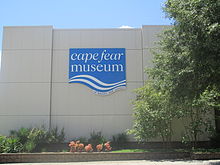
New Hanover County is a county located in the U.S. state of North Carolina. As of the 2020 census, the population was 225,702. Though the second-smallest county in North Carolina by land area, it is one of the most populous, as its county seat, Wilmington, is one of the state's largest communities. The county was created in 1729 as New Hanover Precinct and gained county status in 1739. New Hanover County is included in the Wilmington, NC Metropolitan Statistical Area, which also includes neighboring Pender and Brunswick counties.

Brunswick County is the southernmost county in the U.S. state of North Carolina. As of the 2020 census, the population was 136,693. Its population was only 73,143 in 2000, making it one of the fastest-growing counties in the state. With a nominal growth rate of approximately 47% in ten years, much of the growth is centered in the eastern section of the county in the suburbs of Wilmington such as Leland, Belville and Southport. The county seat is Bolivia, which at a population of around 150 people is among the least populous county seats in the state.
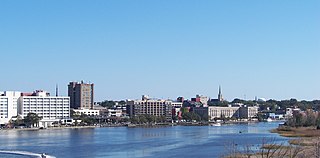
Wilmington is a port city in and the county seat of New Hanover County in coastal southeastern North Carolina, United States. With a population of 115,451 in the 2020 census, it is the eighth-most populous city in the state. Wilmington is the principal city of the Wilmington, NC Metropolitan Statistical Area, which includes the Pender, and Brunswick counties in southeastern North Carolina as well as New Hanover county. Its metropolitan statistical area had a population of 285,905 in 2020.

Fort Fisher was a Confederate fort during the American Civil War. It protected the vital trading routes of the port at Wilmington, North Carolina, from 1861 until its capture by the Union in 1865. The fort was located on one of Cape Fear River's two outlets to the Atlantic Ocean on what was then known as Federal Point or Confederate Point and today is known as Pleasure Island. The strength of Fort Fisher led to its being called the Southern Gibraltar and the "Malakoff Tower of the South". The battle of Fort Fisher was the most decisive battle of the Civil War fought in North Carolina.
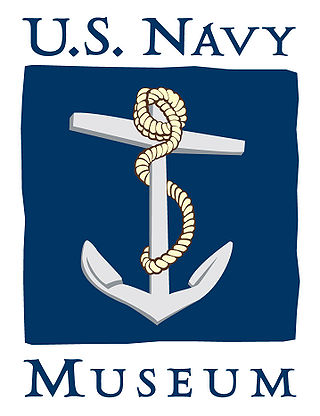
The National Museum of the United States Navy, or U.S. Navy Museum for short, is the flagship museum of the United States Navy and is located in the former Breech Mechanism Shop of the old Naval Gun Factory on the grounds of the Washington Navy Yard in Washington, D.C., United States.

In North Carolina, the Crystal Coast is an 85-mile stretch of coastline that extends from the Cape Lookout National Seashore, which includes 56 miles of protected beaches, southwestward to the New River. The Crystal Coast is a popular area with tourists and second-home owners in the summer.
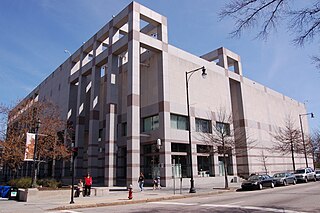
The North Carolina Museum of History is a history museum located in downtown Raleigh, North Carolina. It is an affiliate through the Smithsonian Affiliations program. The museum is a part of the Division of State History Museums, Office of Archives and History, an agency of the North Carolina Department of Cultural Resources.

The Oregon Historical Society Museum is a history museum housed at the Oregon Historical Society in downtown Portland, Oregon, United States. The museum was created in 1898 and receives about 44,000 visitors annually.

The North Carolina Maritime Museum is a system of regional museums within the North Carolina Museum of History, which in turn part of the North Carolina Department of Natural and Cultural Resources. There are several branches of the Maritime Museum located in Beaufort, Southport and Hatteras.

Cape Fear is a coastal plain and Tidewater region of North Carolina centered about the city of Wilmington. The region takes its name from the adjacent Cape Fear headland, as does the Cape Fear River which flows through the region and empties into the Atlantic Ocean near the cape. Much of the region's populated areas are found along the Atlantic beaches and the Atlantic Intracoastal Waterway, while the rural areas are dominated by farms and swampland like that of the Green Swamp. The general area can be also identified by the titles "Lower Cape Fear", "Wilmington, NC Metropolitan Statistical Area", "Southeastern North Carolina", and "Azalea Coast". The latter name is derived from the North Carolina Azalea Festival held annually in Wilmington. Municipalities in the area belong to the Cape Fear Council of Governments.

Pleasure Island is a coastal barrier island in Southeastern North Carolina, United States, just south of the City of Wilmington. Pleasure Island is located within Federal Point Township, in New Hanover County. The coastal resort towns of Carolina Beach and Kure Beach, as well as the annexed communities of Wilmington Beach and Hanby Beach are located on the island. The southern end of Pleasure Island was separated from Bald Head Island by Corncake Inlet until the inlet was shoaled and closed in 1998 by Hurricane Bonnie; thus Pleasure Island and Bald Head Island are no longer separate islands.

Fort Anderson is a mid-19th-century earthen fort in the lower Cape Fear Region of North Carolina, located over the ruins of the colonial town of Brunswick in Brunswick County. It was built as a Confederate Fort by major general Samuel Gibbs French during the American Civil War. The fort was pivotal in protecting the Cape Fear River inlets and Wilmington upstream. Earthen batteries comprise the fort and were used as platforms and shields for the Confederate cannons. Beneath some of the earthworks were "bombproofs," shelters used by troops during enemy bombardment. The Confederacy decided to build forts around the Cape Fear River to protect the port of Wilmington from the Union blockade. During the Civil War, blockade runners brought supplies such as iron, guns, and ammunition to the Confederacy. The purpose of the fort was to hinder movement of Union ships, and to serve as a dropping off point for blockade runners fortunate enough to make it up the mouth of the Cape Fear River. Fort Anderson was built on the ruins of Brunswick Town and was originally named Fort St. Philip, after the ruins of the Revolutionary period church nearby. The name was changed to honor Col. George B. Anderson.
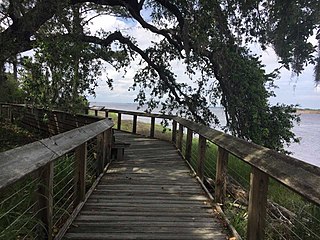
Brunswick Town was a prominent town in colonial North Carolina. It was the first successful European settlement in the Cape Fear region, a major British port in the 18th century, and home to two provincial governors. Brunswick Town lasted 50 years (1726–1776) until it was raided by the British Army during the American Revolutionary War and never rebuilt. During the American Civil War, 86 years after the town was abandoned, a large portion of the town was covered by earthworks for the construction of Fort Anderson.

Cape Fear Community College (CFCC) is a public community college in Wilmington, North Carolina. It enrolls nearly 23,000 students each year. The service area of Cape Fear Community College includes New Hanover and Pender counties with a main campus located in downtown Wilmington and satellite campuses in Castle Hayne, Burgaw, and Surf City.

The George Davis Monument is a monument to attorney and Confederate politician George Davis that was erected in Wilmington, North Carolina by the United Daughters of the Confederacy. It was removed by the City of Wilmington in August 2021.

The Cape Fear Public Transportation Authority, operating as Wave Transit, is the public transportation operator for the metro area of Wilmington, North Carolina. Sixteen regular routes are provided, with all but one running seven days per week. A free downtown shuttle also runs using road trolleys.
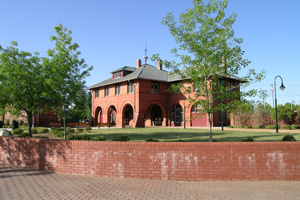
Cape Fear and Yadkin Valley Railway Passenger Depot is a historic train station located at 325 Franklin Street in Fayetteville, North Carolina. It was built in 1890 by the Cape Fear and Yadkin Valley Railway. It is a two-story brick passenger depot with a deep hip roof in the Romanesque Revival style. The seven bay by two bay building features a rounded brick arch arcade. It was listed on the National Register of Historic Places in 1983.
The following is a timeline of the history of the city of Wilmington, North Carolina, United States.

The Museum of Idaho (MOI) is a history and science museum in downtown Idaho Falls, Idaho. The museum features exhibits, collections, and programs focused on the social and environmental history of Idaho and the Intermountain West, as well as prominent traveling exhibits on a variety of subjects. Its tagline is “bringing the world to Idaho, and Idaho to the world”.
Lethia Sherman Hankins was an educator, civic leader, and politician who was active in Wilmington, North Carolina. In 2005 she received national award from the YWCA, the Dorothy I. Height Racial Justice Award, and in 2020 her portrait was one of five commissioned to hang in Bellamy Mansion in honor of North Carolinian women who impacted women, as part of the centennial celebrations of the League of Women Voters for the ratification of the 19th Amendment.
